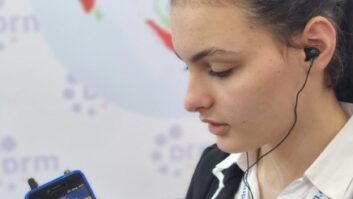COLOGNE, Germany A German consortium has found a new angle for satellite radio: Using old satellites to deliver file-based programs to listeners in their cars.
Not only does this solution allow for broadcasting to mobile users without the need for terrestrial repeaters, according to proponents; it also allows users to determine their own program preferences.
The European Space Agency, which promoted the project with nine partners, said its team has designed a flat, mobile antenna built into a car roof. The antenna receives Ku frequency band signals from existing satellites, saving ESA from the cost of launching new satellites.
The agency and its partners worked on the system for more than three years. A challenge was that the satellites used by the system were designed to broadcast television signals to large, fixed dish antennas. For use in cars, they needed a new approach to achieve an antenna that they say can be built in easily by car manufacturers.
The prototype system has been tested and found to work, though it will be some time a while before it is commercially available.
Direct contact
“Satellites usually have to be taken out of service, not because they cannot broadcast any more,” said Erich Lutz of the German space agency, which developed the packet-based transmission system and organized the reception tests.
“The problem,” said Lutz, “is that they run out of fuel to power the motors that keep them exactly in [their orbital] position. That is no good for reception by a fixed dish on a house roof, but it is no problem for the dish on a car, because it has to follow the satellite anyway.”
Time on these end-of-life satellites is relatively cheap, consortium members say, and they stay in orbit until the satellite operator is ready to replace them. “There are always several available,” said Lutz, “and when one is ready to be removed, we can send an instruction to the dish to select another.”
But satellite radio signals may be blocked by tall buildings, trees or other obstructions. That’s why Sirius Satellite Radio and XM Satellite Radio back up their transmission system with terrestrial repeaters.
Satellite radio in the United States transmits on S-band. Ku-band transmission may be an issue, detractors say, for two reasons: There is no industry standard and geostationary satellites can have poor coverage in Europe.
This is why instead of transmitting programming streams, the German consortium decided to send packets of data and to reconstruct the packets within the receiver.
Several streams
Audio is encoded using aacPlus and divided into files that are delivered as separate data packets. After reception by the user, the files are cached, with material lost due to reception problems retrieved from redundant packets sent with a short delay.
As soon as all the packets that make up a complete program arrive, the user can play it, usually just minutes after origination, the proponents say. Received signals can also be stored for later playback.
In addition to the audio files, the satellite also sends separate files with instructions for program reassembly. Several streams can be multiplexed simultaneously, in which case a multiplex configuration file must also be transmitted.
Proponents, including BMW and Deutsche Welle, dubbed the new system Ku-Mobile, because it uses the 11 GHz Ku-band.
A BMW X5 SUV and a Mercedes-Benz E-Class auto both fitted with Ku-Mobile receiving equipment drove around Europe in January to prove the concept.
Listening trends
The results of the project were presented that same month to an audience at the European Space Research and Technology Centre in the Netherlands.
Wilfried Runde of German foreign-service broadcaster Deutsche Welle, which provided programming for the project, said that the idea of mobile reception throughout Europe via a single satellite has attractions. Deutsche Welle prepared four music selections for the test.
But the system also fits current listening patterns, which favor personally tailored programming. “Listeners are able to select whether they want more news or more music,” said Runde. “They can choose to leave out the sport or select world music rather than pop.”
For Deutsche Welle, the challenge was to tailor its existing output to the technology. “We could not broadcast our usual half-hour current affairs program in one go,” said Runde. “We had to break it up into smaller units and send each bit separately. We were interested to find out if it would be assembled again properly.”
By sending more data packages than necessary for a continuous broadcast, the system can bridge gaps caused by breaks in reception. “We can have some spare science pieces, for example,” said Runde, “which can be played if the listener has recorded an interest in science.”
The technology means that programming, although not reception, can continue in tunnels or underground parking lots.
But it is not necessary to listen to the programming in the context intended by the broadcaster. For example, listeners could intersperse news bulletins or other program segments between tracks from their CD or MP3 player.
Data packages can deliver more than just audio material. The system allows for the transmission of program-associated data or independent files, such as maps or software updates for automobiles.
Though there have been no market tests, one of the aims of the project was to demonstrate commercially attractive applications that could eke out additional years of life for decommissioned telecommunications satellites.
Leslie Stimson contributed to this story.












